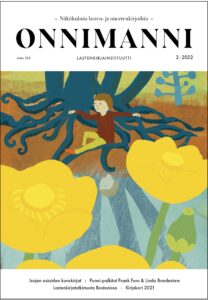
This year’s second issue of Onnimanni features two articles on the broadening scope of picturebook themes.
Heli Halme’s article deals with four new Finnish picturebooks about alcoholism, transgenderism, death and family conflicts – that is, issues that many adults find hard to address together with children. In her keen analyses, Halme shows how important the illustrations are when tackling such complex themes. She urges adults to open-mindedly read these picturebooks, despite their sensitive subject matter, with children; and reminds adults to make room for children’s own interpretations and questions after reading.
Frank Furu and Linda Bondestam’s picturebook Ni är inte min mamma (Förlaget 2021) tells the story of a small refugee girl Aysha, who arrives in Finland without her parents. In Päivi Heikkilä-Halttunen’s interview, the picturebook artists relate how the book came about. A significant help when dealing with this – within a Finnish context – unusual subject matter, was that Furu had worked with refugee children for many years. Bondestam, who is known for her frequent use of animal characters in her picturebooks, found it challenging to make the illustrations both realistic and hopeful. The picturebook was awarded The Finnish Institute for Children’s Literature’s Punni Literature Award, which is given annually to first-time, courageous or innovative Finnish children’s authors and illustrators.
Illustrator Pirita Tolvanen has spent her spring term as a Fulbright-scholar at the 45-year-old, pioneering Center for the study of Children’s Literature at Simmons University in Boston, Massachusetts. Master’s students graduating from their children’s literature programmes end up working as, for instance, publishers, librarians, teachers or researchers. Picturebook classes are frequently arranged at the Eric Carle Museum of Picture Book Art located near-by in Amherst.
According to the Institute’s annual Kirjakori-statistics, 1222 books for children and young adults were published in Finland last year. For the fifth year in a row, the number of Finnish originals (53%) increased. Among translations, English-language books still dominate (71%). The settings in translated books are still predominantly European and Anglo-American; and fewer titles than before feature other cultures and their story traditions. In the Kirjakori-report, Kaisa Laaksonen also notices that – for the third year in a row – the number of Finnish novels for young adults has decreased.
Translation: Maria Lassén-Seger
